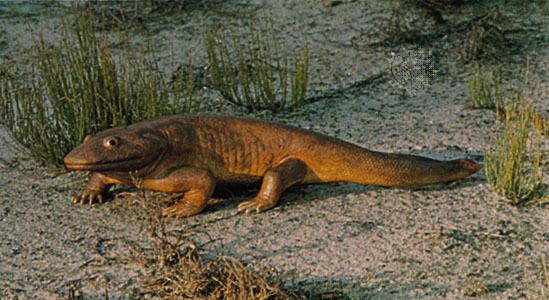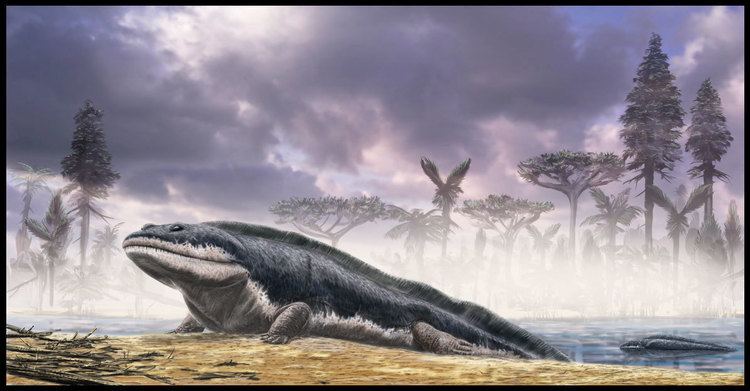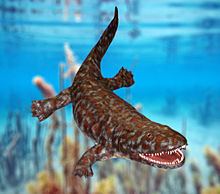Phylum Chordata Rank Genus | Clade Tetrapodomorpha Scientific name Ichthyostega Higher classification Stegocephalia | |
 | ||
Similar | ||
Ancestral evolution ichthyostega to varanops
Ichthyostega (Greek: "fish roof") is an early tetrapod genus that lived at the end of the Upper Devonian period. It was a labyrinthodont, one of the first tetrapods in the fossil record. Ichthyostega possessed lungs and limbs that helped it navigate through shallow water in swamps. Though undoubtedly of amphibian build and habit, it is not considered a true member of the group in the narrow sense, as the first true amphibians appeared in the Carboniferous period. Until finds of other early tetrapods and closely related fishes in the late 20th century, Ichthyostega stood alone as the transitional fossil between fish and tetrapods, combining a fishlike tail and gills with an amphibian skull and limbs.
Contents
- Ancestral evolution ichthyostega to varanops
- Ichthyostega tribute
- Description
- History and classification
- Relationships
- Adaptations for terrestrial life
- References

Ichthyostega tribute
Description

Ichthyostega was a fairly large animal, broadly built and about 1.5 m long. The skull was flat with dorsally placed eyes and armed with large labyrinthodont teeth. The posterior margin of the skull formed an operculum covering the gills. The spiracle was situated in an otic notch behind each eye.

The limbs were large compared to contemporary relatives, and it had seven digits on each hind limb. The exact number of digits on the forelimb is not yet known, since fossils of the manus (hand) have not been found. Although the forelimbs have never been recovered, they are generally thought to have been larger than the rear limbs, perhaps as an aid to carrying its body out of the water. It had a fin containing fin rays on its tail.
History and classification

In 1932 Gunnar Säve-Söderbergh described four Ichthyostega species from the Upper Devonian of East Greenland and one species belonging to the genus Ichthyostegopsis, I. wimani. These species could be synonymous (in which case only I. stensioei would remain), because their morphological differences are not very pronounced. The species differ in skull proportions, skull punctuation and skull bone patterns. The comparisons were done on 14 specimens collected in 1931 by the Danish East Greenland Expedition. Additional specimens were collected between 1933 and 1955.
The genus is related to Acanthostega gunnari, also from East Greenland. Ichthyostega's skull seems more fish-like than that of Acanthostega, but its girdle (shoulder and hip) morphology seems stronger and better adapted to land-life. Ichthyostega also had more supportive ribs and stronger vertebrae with more developed zygapophyses. Whether these traits were independently evolved in Ichthyostega is debated. It does however show that Ichthyostega may have ventured onto land on occasions, unlike the very first tetrapods such as Elginerpeton and Obruchevichthys.
Relationships
Traditionally, Ichthyostega was considered part of an order named for it, the "Ichthyostegalia". however, this group represents a paraphyletic grade of primitive stem-tetrapods and is not used by many modern researchers. Phylogenetic analysis has shown Ichthyostega is intermediate between other primitive stegocephalian stem-tetrapods. The evolutionary tree of early stegocephalians below follows the results of one such analysis performed by Swartz in 2012.
Adaptations for terrestrial life
Early tetrapods like Ichthyostega and Acanthostega differed from earlier tetrapodomorphs such as Eusthenopteron or Panderichthys in their increased adaptations for life on land. Though tetrapodomorphs possessed lungs, they used gills as their primary means of discharging carbon dioxide. Tetrapodomorphs used their bodies and tails for locomotion and their fins for steering and braking; Ichthyostega may have used its forelimbs for locomotion on land and its tail for swimming.
The size of an adult Ichthyostega was (1.5 m). The massive ribcage was made up of overlapping ribs and the animal possessed a stronger skeletal structure, a largely fishlike spine, and forelimbs apparently powerful enough to pull the body from the water. These anatomical modifications may have evolved to handle the lack of buoyancy experienced on land. The hindlimbs were smaller than the forelimbs and unlikely to have borne full weight in an adult, while the broad, overlapping ribs would have inhibited side-to-side movements. The forelimbs had the required range of movement to push the body up and forward, probably allowing the animal to drag itself across flat land by synchronous (rather than alternate) "crutching" movements, much like that of a mudskipper or a seal. It was incapable of typical quadrupedal gaits as the forelimbs lacked the necessary rotary motion range.
